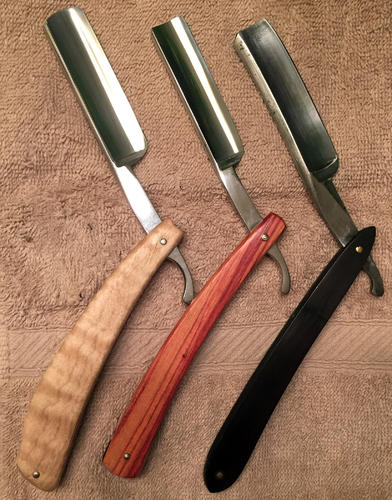Results 1 to 10 of 34
Hybrid View
-
12-02-2015, 02:04 PM #1
 A littel quality time touching up the rotation on the 12K
A littel quality time touching up the rotation on the 12K
Just a quick picture of the touched up line up. Spent a little time refreshing these three. Little more than a touch up on the Dovo. Left to right: Dovo (with my home made scale as the factory one cracked at the pin), Ralph Aust, and Charles Congreve (Sheffield 1829 - 1843) which I bought from Badgister in the classifieds (a great shaver).
The Dovo needs more work - some time ago my wife knocked it off the stand while it was drying and put a chip in the blade. It didn't feel right and under magnification I could see the damage. Had to go back to the 1K Naniwa to grind out the chip, and then worked it on the Norton 4/8 and up to the 12K Naniwa but it's not back to where I want it. I finish them all on CO pasted felt. It has a sharp edge - passes the hanging hair test but it still feels pretty harsh on the face. Maybe it just doesn't like my Naniwa 12K? Both of the other razors love the 12K - the Aust is incredibly sharp and I have a slice healing up nicely on my ear to prove it!
Adam

-
12-02-2015, 03:51 PM #2

Nice set of razors,, keep up the good work.
-
12-02-2015, 04:21 PM #3

Nice rotation! I do the same thing- touch up my blades on a rotation so they never get dull to the point of needing rehoning.
-
12-03-2015, 04:49 PM #4

I have a couple more in the rotation, but just worked on these three. The Dovo is still giving me fits. I had to take it back to bevel set and work out a chip I mentioned above - and just can't seems to get back to a comfortable shave. It looks good under magnification, passes the HHT but just feels like crap on a shave.
Adam
-
12-05-2015, 07:13 PM #5
-
12-07-2015, 08:17 PM #6

Any suggestions? What finally worked for you on the Dove
Adam


 24Likes
24Likes LinkBack URL
LinkBack URL About LinkBacks
About LinkBacks







 Reply With Quote
Reply With Quote



